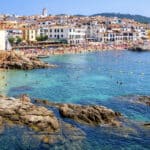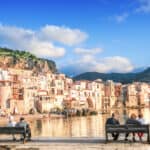Welcome to one of the planet's most beautiful and often overlooked places, Lake Atitlán, Guatemala. Located in the highlands of Guatemala, the lake is surrounded by lush mountains, quaint tiny Mayan villages, and three volcanoes.
But there's more to Lake Atitlán than meets the eye. Buried deep within the mountains and volcanoes is a rich and humbling culture that is too often misunderstood.
With 11 Mayan villages sprinkled around the lake, running out of things to do and see is impossible. Lake Atitlán has everything whether you are looking for a more zen vibe or a party town in Central or South America.
How to Get to Lake Atitlan, Guatemala
Getting to the lake is easy and relatively quick, depending on the weather and road conditions. During the rainy season, the odd mudslide may make for difficult travel, but thankfully, this is not a common occurrence.
Visitors can find many flight options into Guatemala City. At La Aurora International Airport in Guatemala City, you can easily find a shuttle to the lake. If you're on a tight budget, you can take a shuttle into the city where the chicken buses are stationed.
Hiring a private driver before you land is always a good option if money is no object. Expect to pay around $100 for this service.
Getting Around the Lake
Once you are here, getting around the lake is ridiculously easy. Each village has tuk tuks, and for 5 Quetzales, 65 cents US, you can go anywhere within that village.
If you want to hit the next village over, there are a few ways to get there.
- Microbus
- Pickup Truck
- Chicken bus
- Water Taxis (Launchas)
Each means of transportation costs under 10 Quetzales ($1.30 US), depending on where you are headed. The launchas (boats) are the most expensive at up to 25 Quetzales ($3.20 US).
The chicken buses are the main means of transportation throughout Guatemala as they are affordable to all. They are old-school buses decked out with colorful lights, and loud Spanish music can be heard as they whiz by.
Some villages are easy to walk to and well worth the trek. With stunning views of the lake and the three volcanoes from the main roads, you should put on your comfy shoes, grab a bottle of water and walk.
Where to Stay at Lake Atitlán
With 11 villages around the lake, you can easily find a place to stay. If you like high vibes and are looking for some nightlife, San Pedro or Panajachel might be the spots for you.
If you prefer low-key and relaxed, San Marcos, San Juan, or Santa Cruz will be right up your alley. It's good to note that getting around the lake is easy. Water taxis (launchas) run all day continuously and can take you to any village you want.
There are hostels in every village but if you prefer more private accommodations, hotels or Airbnbs are also available. During the high season, October to April, you will pay a little more for hotels.
Some Spanish schools also offer homestays, so booking a 3-week adventure here to learn the culture and the language might interest you.
Interesting Things to Consider Before Booking Your Trip
Mayans inhabit Lake Atitlan, Guatemala, and the culture is vibrant here. Most locals do not speak English. It might help to learn a bit of Spanish before you arrive. Some basic knowledge of numbers and greetings will help you tremendously.
It's also important to remember that while this area is rich in culture, there is quite a bit of poverty here. Feel free to open your wallet and give one Quetzal (equivalent to 13 cents US) to a child on the street.
You should secure local currency before you get here. If you didn't get a chance to do that, there are ATMs everywhere, and while the majority are safe, some aren't. Visa and debit cards are accepted at all restaurants but not all stores. Cash is the preferred payment method, especially for street vendors.
While Lake Atitlán is stunning beyond belief, the streets are often littered with garbage, and street dogs are everywhere. The dogs are rarely aggressive, but you should be cautious, especially if you are out late at night.
Some towns are quiet and laid back, while others, like Panajachel, are loud and have lots of traffic. A visit to the lake will be complete if you check out all 11 villages to get a good feel of what Lake Atitlán is all about.
10 Things to See and Do Around Lake Atitlan, Guatemala
There are numerous attractions and activities to explore. From chilling out on one of the many small beaches to more extreme adventures like paragliding, here are ten things to see and do at Lake Atitlán, Guatemala.
1 – Explore the Mayan Villages
There are 11 charming Mayan villages around Lake Atitlán, each with distinct character and traditions. Take a boat ride, jump in a tuk-tuk, hop in the back of a pickup truck, or grab a microbus or chicken bus to some of these destinations.
Some popular villages to explore include:
- Panajachel
- San Pedro La Laguna
- Santiago Atitlán
- Santa Cruz La Laguna
- San Juan
- San Marcos La Laguna.
Immerse yourself in the local culture, visit handicraft markets, interact with the locals, and learn about their traditional way of life.
2 – Hike the Volcanoes
Embark on a hiking adventure to one of the volcanoes surrounding Lake Atitlán. The most popular options are Volcán San Pedro, Volcán Tolimán, and Volcán Atitlán. Hiking one of these volcanoes offers scenic views of the lake and the surrounding landscape. The hikes vary in difficulty, so choose one that suits your fitness level and enjoy the stunning backdrop. It's advisable to go with a local guide for safety and to learn about the area's flora, fauna, and geological features.
3 – Water Activities Around the Lake
For a more thrilling experience, rent a kayak or try stand-up paddleboarding on the lake. Paddle along the calm waters, explore hidden coves, and enjoy the peaceful surroundings. It's a great way to connect with nature and appreciate the tranquillity of Lake Atitlán. Not into water sports? You can still jump on a ‘Party Boat' and get a tour around the lake.
4 – San Juan La Laguna
Visit the San Juan La Laguna village, known for its vibrant art scene and sustainable practices. This charming little area recently got a facelift and has become one of the more popular villages around the lake. In San Juan, you can learn about traditional weaving techniques, natural dyeing, and other indigenous arts and crafts. Explore the local art galleries and workshops, where you can observe artists at work and purchase unique artworks. While you're there, check out the coffee and chocolate tour.
5 – Relax on the Beaches
Lake Atitlán has several beaches where you can relax in the sunshine. Santa Cruz La Laguna and San Marcos La Laguna have lovely lakeside spots to unwind, swim, or enjoy stunning views. Lake Atitlán is safe to swim in, but it's important to note that you swim at your own risk. There are no lifeguards at any of the beaches, and getting caught up in seaweed can be dangerous.
6 – Visit the Maximon Shrines
Maximon, also known as San Simon, is an esteemed folk saint in the Mayan culture. Several villages around Lake Atitlán have Maximon shrines where you can observe the rituals and offerings made to this spiritual figure. Santiago Atitlán is mainly known for its Maximon ceremonies. You must hire a local guide to visit Maximon and partake in a ceremony. You can learn more about that here.
7 – Yoga and Wellness Retreats
Lake Atitlán is known for its tranquil and spiritual atmosphere, making it a popular destination for yoga and wellness retreats. Join a yoga class or retreat to rejuvenate your mind, body, and soul amidst the lake's natural beauty. San Marcos is home to many retreats.
8 – Explore Natural Reserves
Discover the natural reserves and protected areas near Lake Atitlán. One such reserve is the Atitlán Nature Reserve, which offers hiking trails through forests, diverse wildlife, and panoramic viewpoints. You can also visit the Cerro Tzankujil Nature Reserve, known for its butterfly garden and scenic routes. The Nature Reserve is also the spot to go if you're into ziplining or walking on swing bridges. You won't be disappointed with a visit to the reserve.
9 – Enjoy Ecotourism
Lake Atitlán and its surrounding areas offer opportunities for ecotourism. Join a guided nature walk, birdwatching excursion, or coffee farm tour to learn about the region's biodiversity, sustainable agriculture, and conservation efforts.
10 – Experience Local Cuisine
Indulge in the flavors of Guatemalan cuisine around Lake Atitlán. Sample traditional dishes such as pepián (a spicy meat stew) and chiles rellenos (stuffed peppers), or try local specialties like atol (a traditional corn-based hot drink). After dark in Panajachel, the streets come alive with food carts and pop-up restaurants. Your visit won't be complete until you check out the street food at night. Don't forget to taste the locally grown coffee known for its quality.
Chilling out at Lake Atitlán
These are just a few noteworthy highlights of what you can see and do around Lake Atitlán. The area's natural beauty, artistic heritage, and outdoor activities make it an enthralling experience for travelers seeking relaxation and adventure.
If you prefer to chill out, or get to know the locals, taking a stroll down the main street of Panajachel might be your thing. With plenty of outdoor cafes and hang-out spots, it's easy to relax and strike up a conversation with a local (Google Translate will be your best friend if you don't speak Spanish).
Key Factors to Note Before Your Trip
Before traveling to Lake Atitlan, Guatemala, you must consider a few essential things to ensure a smooth and enjoyable trip. Here are some key factors to keep in mind:
- Visa and Entry Requirements: Check the visa requirements for Guatemala based on your nationality. Check with the Guatemalan embassy or consulate for the most up-to-date information. If you plan on staying longer than 90 days, you must leave the country for at least 72 hours to extend your travel permit.
- Health and Safety: Consult your healthcare provider before visiting Lake Atitlán. They can provide guidance on vaccinations, travel health advisories, and necessary medications. If you get sick while at the lake, there are many public and private clinics with excellent doctors and health care, all very affordable.
- Weather: Lake Atitlán is situated at a high altitude, and the weather can differ throughout the year; therefore, it is vital to research the climate for your travel dates and pack accordingly. Even during the warmer months, evenings can be chilly, so bring layers. Remember essentials like sunscreen, a hat, comfortable walking shoes, and a rain jacket or umbrella. If you plan on hiking or exploring the volcanoes, pack appropriate gear and check local conditions.
- Cultural Considerations: Lake Atitlán is home to Mayan communities with unique traditions and customs. Respect the local culture when visiting villages or sacred sites. Learn a few basic phrases in Spanish or the local Maya languages, such as greetings and polite expressions. Be mindful of local customs and seek permission before taking photographs of individuals. Some may ask you to pay 10 Quetzales for you to take their pic.
- Safety Precautions: As with any travel destination, you must be informed about your surroundings and follow local advice. Though Guatemala has previously been considered one of the most dangerous countries in the world, most crimes are drug-related or domestic violence related. The Lake Atitlán area is extremely safe; the only danger is falling in love with the area and never wanting to return home!
What Are You Waiting For?
If Guatemala was never on your list of places to travel, we hope it is now. Lake Atitlán is a must-see destination with perfect spring-like weather, warm and friendly people, and landscapes like you've never seen before.
Two weeks minimum is advised for a visit; one month is recommended in order to enjoy the full Guatemalan experience.
Word of warning: Once you leave, you'll be making plans to return. This article originally appeared on Savoteur.







